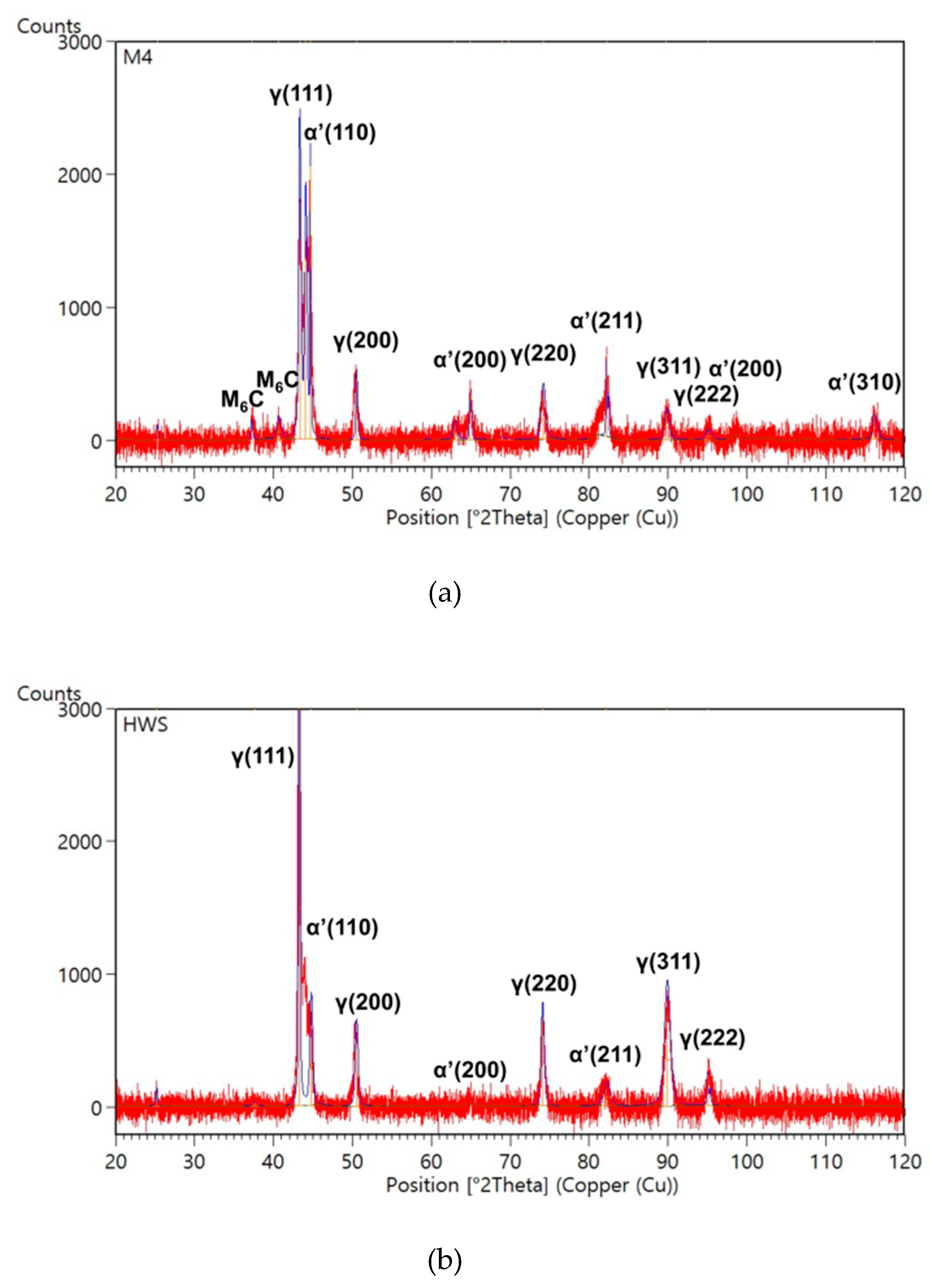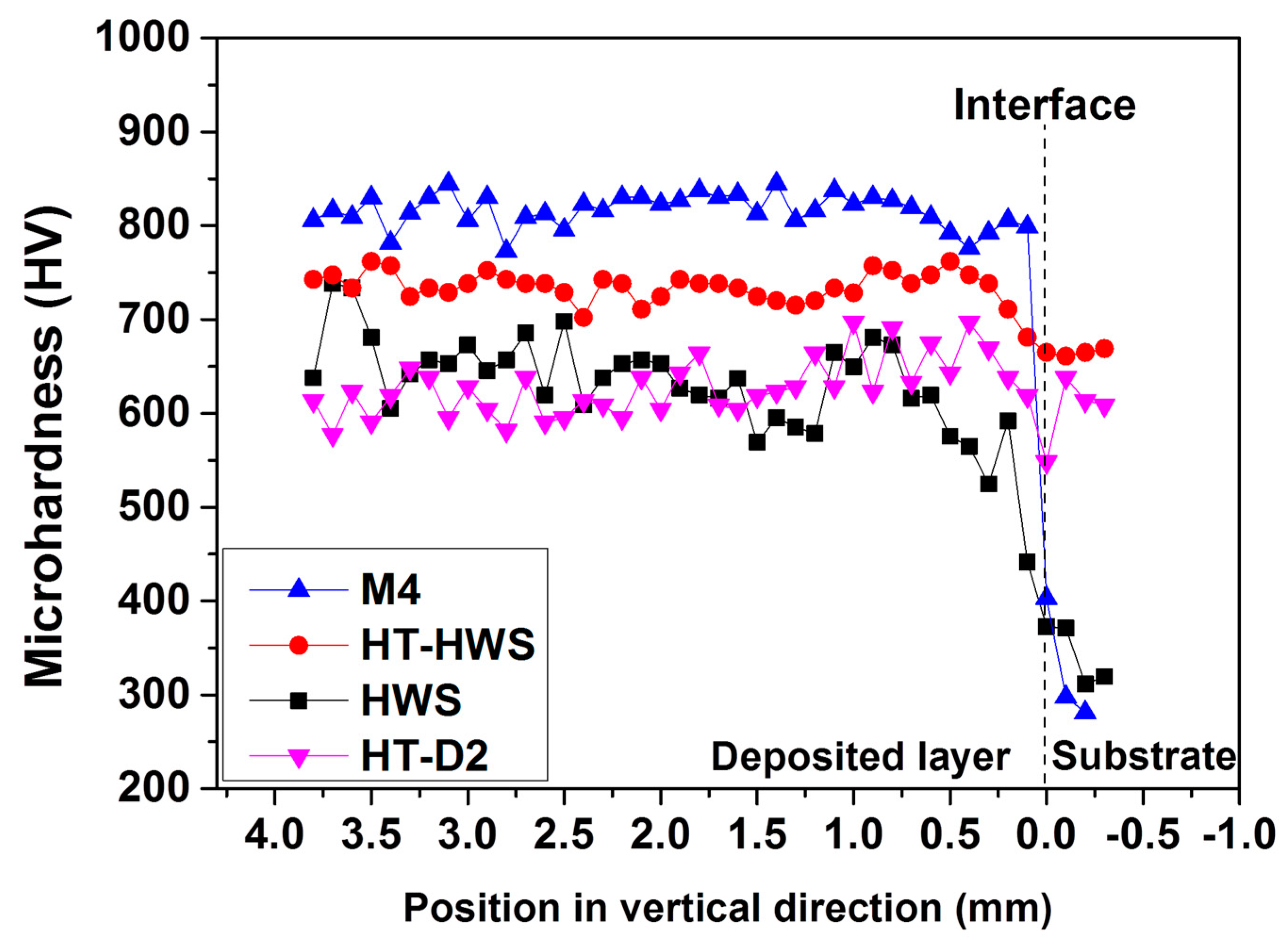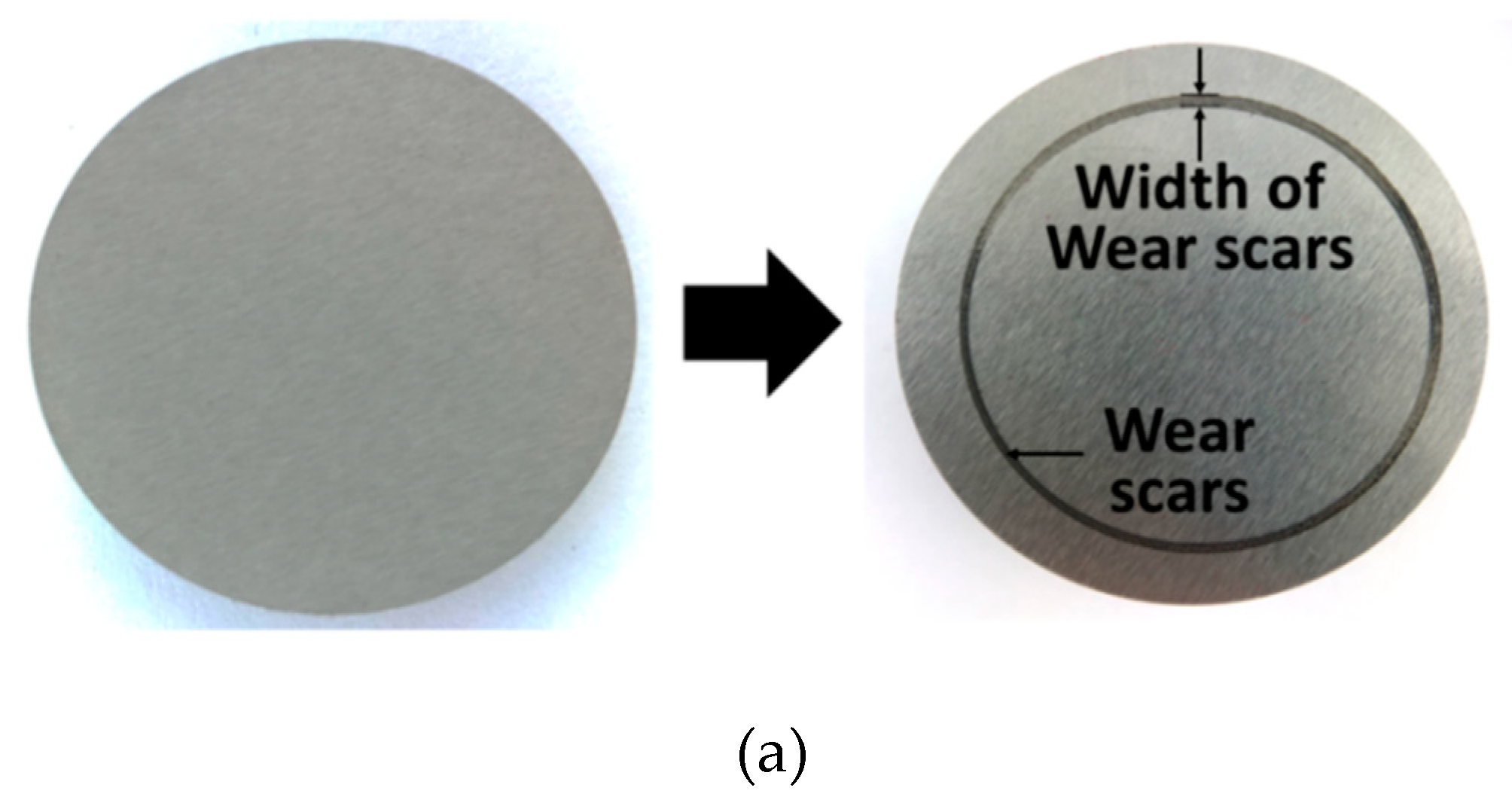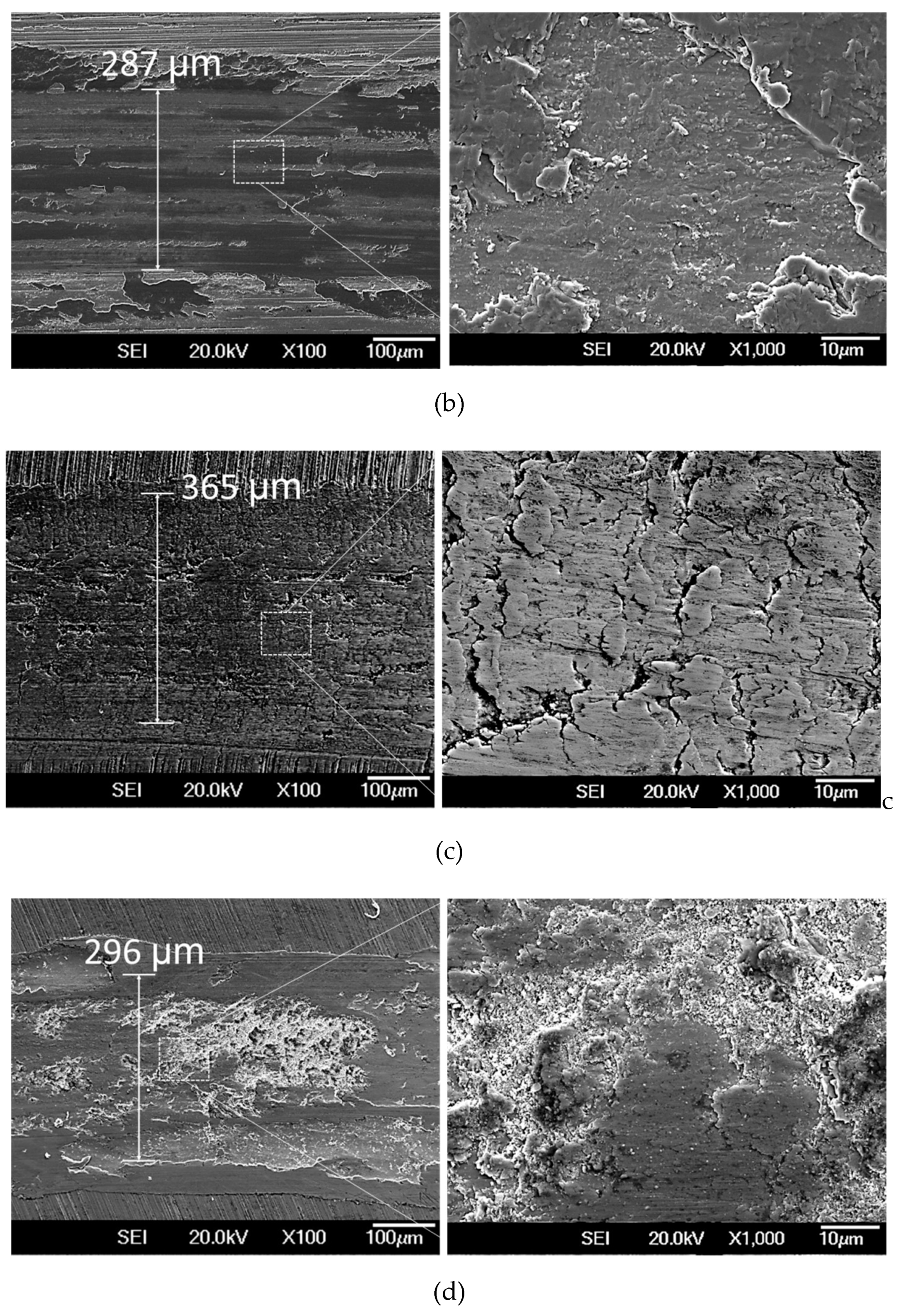Mechanical Properties of Tool Steels with High Wear Resistance via Directed Energy Deposition
Abstract
:1. Introduction
2. Materials and Methods
2.1. Materials
2.2. Directed Energy Deposition (DED)
2.3. Experimental Procedure
3. Results and Discussion
3.1. X-ray Diffraction
3.2. Microstructure
3.3. Micro-Hardness
3.4. Wear
3.5. Toughness
4. Conclusions
Author Contributions
Funding
Conflicts of Interest
References
- Shamsaei, N.; Yadollahi, A.; Bian, L.; Thompson, S.M. An overview of Direct Laser Deposition for additive manufacturing; Part II: Mechanical behavior, process parameter optimization and control. Addit. Manuf. 2015, 8, 12–35. [Google Scholar] [CrossRef]
- Saboori, A.; Gallo, D.; Biamino, S.; Fino, P.; Lombardi, M. An Overview of Additive Manufacturing of Titanium Components by Directed Energy Deposition: Microstructure and Mechanical Properties. Appl. Sci. 2017, 7, 883. [Google Scholar] [CrossRef]
- Telasang, G.; Majumdar, J.D.; Padmanabhan, G.; Manna, I. Structure–property correlation in laser surface treated AISI H13 tool steel for improved mechanical properties. Mater. Sci. Eng. A 2014, 599, 255–267. [Google Scholar] [CrossRef]
- Telasang, G.; Majumdar, J.D.; Padmanabhan, G.; Tak, M.; Manna, I. Effect of laser parameters on microstructure and hardness of laser clad and tempered AISI H13 tool steel. Surf. Coat. Technol. 2014, 258, 1108–1118. [Google Scholar] [CrossRef]
- Wang, S.H.; Chen, J.Y.; Xue, L. A study of the abrasive wear behaviour of laser-clad tool steel coating. Surf. Coat. Technol. 2006, 200, 3446–3458. [Google Scholar] [CrossRef]
- Shim, D.S.; Baek, G.Y.; Lee, E.M. Effect of substrate preheating by induction heater on direct energy deposition of AISI M4 powder. Mat. Sci. Eng. A 2017, 682, 550–562. [Google Scholar] [CrossRef]
- Shim, D.S.; Baek, G.Y.; Lee, S.B.; Yu, J.H.; Choi, Y.S.; Park, S.H. Influence of heat treatment on wear behavior and impact toughness of AISI M4 coated by laser melting deposition. Surf. Coat. Technol. 2017, 328, 219–230. [Google Scholar] [CrossRef]
- Farahmand, P.; Kovacevic, R. An experimental numerical investigation of heat distribution and stress field in single-and multi-track laser cladding by a high-power direct diode laser. Opt. Laser Technol. 2014, 63, 154–168. [Google Scholar] [CrossRef]
- Leunda, J.; Navas, V.G.; Soriano, C.; Sanz, C. Improvement of laser deposited high alloyed powder metallurgical tool steel by a post-tempering treatment. Phys. Procedia 2012, 12, 392–400. [Google Scholar] [CrossRef]
- Leunda, J.; Navas, V.G.; Soriano, C.; Sanz, C. Effect of laser tempering of high alloy powder metallurgical tool steels after laser cladding. Surf. Coat. Technol. 2014, 259, 570–576. [Google Scholar] [CrossRef]
- Baek, G.Y.; Shin, G.Y.; Lee, E.M.; Shim, D.S.; Lee, K.Y.; Yoon, H.S.; Kim, M.H. Mechanical characteristics of a tool steel layer deposited by using direct energy deposition. Met. Mater. Int. 2017, 23, 770–777. [Google Scholar] [CrossRef]
- Baek, G.Y.; Lee, K.Y.; Park, S.H.; Shim, D.S. Effects of substrate preheating during direct energy deposition on microstructure, hardness, tensile strength, and notch toughness. Met. Mater. Int. 2017, 23, 1204–1215. [Google Scholar] [CrossRef]
- Briki, J.; Slima, S.B. A New Continuous Cooling Transformation Diagram for AISI M4 High-Speed Tool Steel. J. Mater. Eng. Perform. 2008. [Google Scholar] [CrossRef]
- Ramírez, G.; Mestra, A.; Casas, B.; Valls, I.; Martínez, R.; Bueno, R.; Góez, A.; Mateo, A.; Llanes, L. Influence of substrate microstructure on the contact fatigue strength of coated cold-work tool steels. Surf. Coat. Technol. 2012, 206, 3069–3081. [Google Scholar] [CrossRef]
- Sapate, S.G.; Chopde, A.D.; Nimbalkar, P.M.; Chandrakar, D.K. Effect of microstructure on slurry abrasion response of En-31 steel. Mater. Des. 2008, 29, 613–621. [Google Scholar] [CrossRef]
- Ueda, M.; Uchino, K.; Kobayashi, A. Effects of carbon content on wear property in pearlitic steels. Wear 2002, 253, 107–113. [Google Scholar] [CrossRef]
- Goto, H.; Amamoto, Y. Effects of varying load on wear resistance of carbon steel under unlubricated conditions. Wear 2003, 254, 1256–1266. [Google Scholar] [CrossRef]
- Lin, Y.C.; Wang, S.W.; Chen, T.M. A study on the wear behavior of hardened medium carbon steel. J. Mater. Process. Technol. 2002, 120, 126–132. [Google Scholar] [CrossRef]
- Nanesa, H.G.; Jahazi, M. Alternative phase transformation path in cryogenically treated AISI D2 tool steel. Mater. Sci. Eng. A 2015, 634, 32–36. [Google Scholar] [CrossRef]














| Materials | Element (wt.%) | ||||||||||
|---|---|---|---|---|---|---|---|---|---|---|---|
| C | Si | Mn | P | S | Ni | Cr | Mo | Cu | V | W | |
| AISI D2 (substrate) | 1.56 | 0.24 | 0.25 | 0.025 | 0.001 | 0.175 | 11.31 | 0.83 | 0.14 | 0.25 | - |
| AISI M4 | 1.33 | 0.33 | 0.26 | 0.03 | 0.03 | 0.3 | 4.25 | 4.88 | 0.25 | 4.12 | 5.88 |
| HWS | 1.08 | 1.38 | 0.34 | - | - | - | 7.80 | 1.86 | - | 2.66 | 1.73 |
| Powders | Pre-Heating Temp. (°C) | Laser Power (W) | Scanning Speed (mm/min) | Powder Feed Rate (g/min) | Powder Gas Rate (ℓ/min) | Coaxial Gas Rate (ℓ/min) | Slicing Layer Height (mm) | Overlap Width (mm) |
|---|---|---|---|---|---|---|---|---|
| AISI M4 | 250 | 800 | 850 | 5 | 2.5 | 8 | 0.25 | 0.5 |
| HWS | 20 | 800 | 850 | 5 | 2.5 | 8 | 0.25 | 0.5 |
© 2019 by the authors. Licensee MDPI, Basel, Switzerland. This article is an open access article distributed under the terms and conditions of the Creative Commons Attribution (CC BY) license (http://creativecommons.org/licenses/by/4.0/).
Share and Cite
Baek, G.Y.; Shin, G.Y.; Lee, K.Y.; Shim, D.S. Mechanical Properties of Tool Steels with High Wear Resistance via Directed Energy Deposition. Metals 2019, 9, 282. https://doi.org/10.3390/met9030282
Baek GY, Shin GY, Lee KY, Shim DS. Mechanical Properties of Tool Steels with High Wear Resistance via Directed Energy Deposition. Metals. 2019; 9(3):282. https://doi.org/10.3390/met9030282
Chicago/Turabian StyleBaek, Gyeong Yun, Gwang Yong Shin, Ki Yong Lee, and Do Sik Shim. 2019. "Mechanical Properties of Tool Steels with High Wear Resistance via Directed Energy Deposition" Metals 9, no. 3: 282. https://doi.org/10.3390/met9030282




